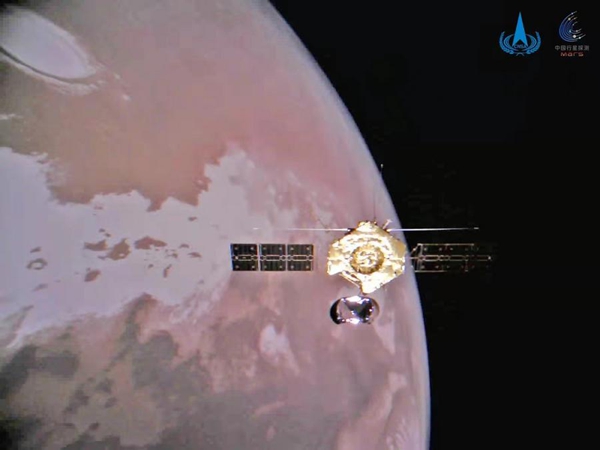China aims to launch Mars sample-return mission around 2028

Photo released on Jan. 1, 2022 by the China National Space Administration (CNSA) shows the group photo of the orbiter and Mars. China released on the first day of 2022 a group of new Mars images taken by the Tianwen-1 probe. (CNSA/Handout via Xinhua)
HEFEI, Sept. 6 (Xinhua) -- China plans to carry out the Tianwen-3 mission through two launches around 2028, aiming to bring back samples from Mars, a Chinese space expert said on Thursday.
Liu Jizhong, chief designer of China's Mars sample-return mission, unveiled the details of the plan at the 2nd International Deep Space Exploration Conference in Tunxi of Huangshan City in east China's Anhui Province.
"China has retrieved the first ever samples from the far side of the moon with the Chang'e-6 mission this year. Since Mars is much farther away than the moon, it will take two launches to carry out the Mars sample-return mission due to the limited carrying capacities of our current rockets. Two Long March-5 carrier rockets will be used for the mission," Liu told Xinhua in an interview.
The primary scientific goal of the mission will be to search for signs of life. Other exploration subjects will include the Martian climate and its evolution, Martian geology and the planet's internal processes.
This mission will be very difficult and challenging, and the Chinese research team has conducted extensive preliminary studies to identify candidate locations with scientific discovery potential, Liu said.
The retrieval of samples from Mars is the most technically challenging space exploration mission since the Apollo program, and such a retrieval has never been realized, Liu said.
To meet this goal, Chinese space engineers have to tackle key tasks such as collecting samples on the Martian surface, taking off from the Red Planet, rendezvousing in the Mars orbit, and protecting the planet from contamination, Liu explained.
The entire process of the mission plan is very complex, involving 13 phases and utilizing in-situ and remote-sensing detection technologies.
Liu said that the mission will use three methods to obtain diverse samples: multi-point surface sampling, fixed-point in-depth drilling and in-flight vehicle sampling.
China will earnestly adhere to international conventions and carry out measures to safeguard both Mars and Earth, as well as the samples, from contamination during the mission, Liu said.
The Tianwen-3 mission will carry payloads developed through international cooperation, and China will collaborate with scientists from around the world to conduct joint research on Mars samples and detection data, Liu said.
In the long term, China will collaborate with other countries or research institutions around the world to complete mission and task definition, requirement analysis, conceptual research, implementation plan design and key technology breakthroughs for the construction of a research station on Mars, Liu added.